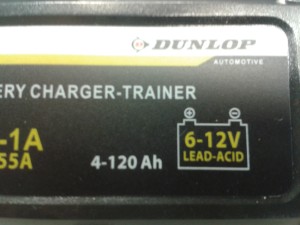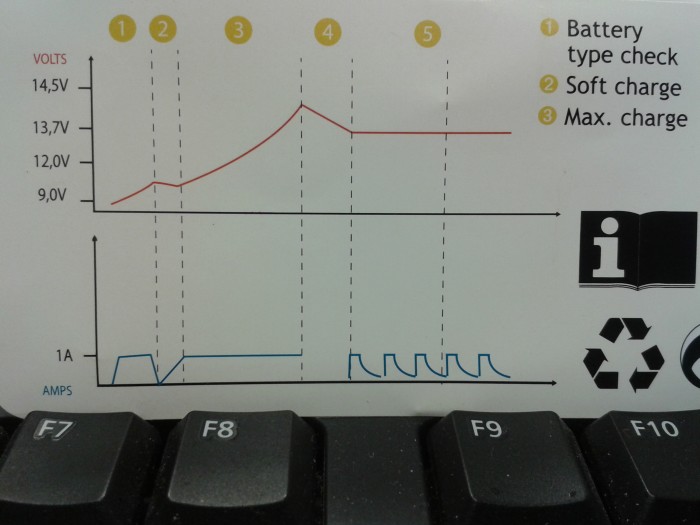REVIEW: El-cheapo battery charger / trainer
Auto 6 V / 12 V voltage detect – and below!
I was curious to see how the charger responded to a battery with one or more cells gone bad owing to sulfation or an internal short circuit. I found a ‘declared dead’ 12-V 12-Ah specimen in the Elektor Labs from BMW biker Jan Visser. With a voltmeter attached I first measured some 9.2 volts from the clunker and then saw the charger doing a one-second “attempt” to apply 12.6 volts and then releasing the load again. No second attempt followed to apply 12.6 volts, and the FAULT indicator came on duly. RIP #1.A second test on a ‘dying’ 12-V gel battery turned out slightly different, where I was able to observe three 1-second attempts to apply about 13 V to the terminals, but FAULT not lighting. The voltmeter however indicated that the charger was effectively disconnected from the load for quite some time, and after a good delay the charging process did start. Sadly for me but technically correct, FAULT lit up after about one hour. RIP #2.
The absolute minimum battery voltages this charger requires before it starts its charging cycle are in the ball parks of 9.5 volts for 12-V nominal, and 4.5 volts for 6-V nominal. I find these limits on the low side, as anything around these values indicates a state of deep discharge and likely defects in the battery.
So this device is not the gel-acid battery rejuvenator I had secretly hoped for. No worries, we still have the 30-mF capacitor for that! No guts, no glory!
Slow charging
This is not a rapid charger. The 1 amp spec for 12 volts and 0.55 amps for 6 volts simply mean it take s a long, long time to charge “normal” size batteries of the 40-60 Ah class found in most cars. Printing a top capacity of 120 Ah on the charger is silly. In my case, it’s winter time soon and my batteries are 6 Ah and 14 Ah only, so no issue.
s a long, long time to charge “normal” size batteries of the 40-60 Ah class found in most cars. Printing a top capacity of 120 Ah on the charger is silly. In my case, it’s winter time soon and my batteries are 6 Ah and 14 Ah only, so no issue.I recorded the terminal voltage and current for a full charge cycle of my empty, but reasonably active, spare 6-V battery and compared it to the interesting graph that came with the charger. I had to scale it down to 6.2 volts and found a consistent error of 0.075 volts up on the battery terminal voltage. That’s not worrying though for lead-acids. The “maintenance” phase is upheld with pulses, which I am not too fond of although the average current is the same as with steady trickle charging in the mA range.

The charger runs slightly warm only in the ramp-up phase when the maximum output current is supplied.
Conclusion
The Z10 charger from Dunlop Automotive is worth every cent of its extremely low price and does what it says on the box. The degree of protection against misuse is impressive. The manual that comes with it is terrible, discussing for the most part a wholly different type of charger. On the bright side, the Z10 has zero user controls so there’s preciously little you can do wrong. It is said to contain a “12-bit AD processor with a 5-phase charge profile” and chuckle as I may about that wording, the technology in the featherlight, very strong box does a great job.If you are a user of small lead-acid, gel or AGM batteries that require winter care or occasional charging, grab one (or a few).
Read full article
Hide full article


Discussion (0 comments)